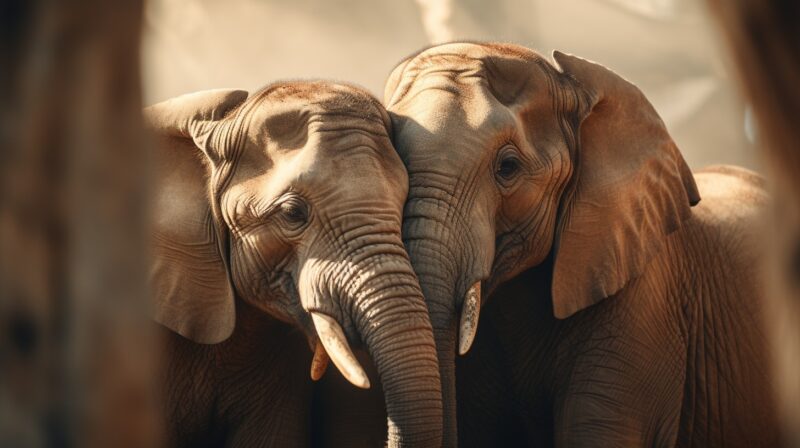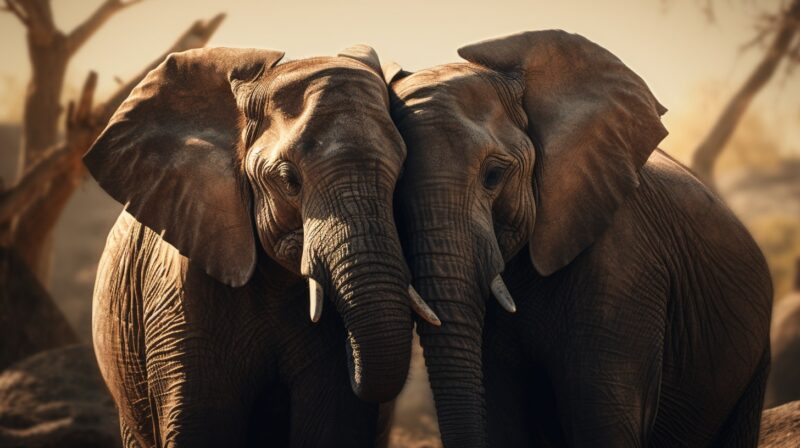Do you ever listen to the sounds of nature around you? Birds chirping early in the morning, a wolf howling in the distance, or frogs croaking near a pond at night? Even though these sound just like background noise to you, they actually represent conversations between animals.
I find it really interesting to learn about how this works. It’s like they have their own secret language that has developed over thousands of years. This communication is key for their survival, finding mates, and living together. Let’s explore how animals use these sounds.
Key Takeaways
- Animals produce sounds using various mechanisms, such as mammals with vocal cords, birds with the syrinx, and insects through body parts like wings or legs.
- For effective communication, animals have developed complex auditory systems that allow them to perceive and interpret sounds accurately.
- The communication systems of animals are highly diverse, with some species capable of producing and interpreting a range of sounds for different purposes, showing the complexity and sophistication of animal communication.
Sound Communication
Sound communication in animals transcends mere noise; it’s a sophisticated transmission of vital information through acoustic signals. This form of communication is not arbitrary but a critical component of animal behavior that has evolved over millions of years.
It plays an indispensable role in the survival and reproductive success of countless species, facilitating everything from mating rituals to territory defense and predator alerts.
Just as these vocalizations are crucial for their social interactions, understanding the diverse ways in which creatures harness energy from their environment is essential for appreciating the full spectrum of their survival strategies.
Production

The methods and mechanisms animals use to produce sounds are as diverse as the animal kingdom itself. These sounds serve as the voices of the natural world, each uniquely adapted to the needs and the environment of the species.
Mammals and Vocal Cords
Mammals rely on vocal cords located in their larynx to produce sounds. These cords can vibrate at different frequencies, allowing mammals to generate a wide range of sounds.
The deep growls of a lion, capable of traveling long distances to assert its presence, contrast sharply with the complex language of dolphins, which consists of clicks, whistles, and other sounds for communication and echolocation in the ocean’s depths.
Similarly, the howls of wolves not only serve as a means of communication within the pack but also reflect their hunting strategies and dietary preferences, from large ungulates in dense forests to smaller mammals and occasional plant-based foods.
Birds and the Syrinx
Birds possess a unique vocal organ called the syrinx, located at the base of their trachea. Unlike mammals, birds can control the muscles of the syrinx with great precision, producing complex songs and calls.
This ability is especially prominent in species like the nightingale, whose intricate melodies not only serve as mating calls but also mark territories.
Insects
Insects might lack vocal cords, but they are by no means silent. Many insects use parts of their bodies to create sounds, a process known as stridulation. Crickets and grasshoppers rub their wings together to produce their characteristic chirping.
This sound, often associated with the tranquility of a summer evening, plays a crucial role in mate attraction and territorial displays.
Sound Reception
Sound production is only half the story. For sound communication to be effective, animals must also be adept at receiving and interpreting these acoustic signals. This requires complex auditory systems that can differentiate between various sounds, discern their meanings, and pinpoint their origins.
The Auditory Systems
The auditory systems of animals are marvels of natural engineering, finely tuned to the specific frequencies and types of sound their species most commonly use. Elephants, for example, can hear and respond to infrasound signals that are below the range of human hearing, allowing them to communicate over long distances.
Owls have asymmetrically placed ears that help them locate the precise position of their prey in complete darkness.
Interpreting Sounds
Hearing is just the beginning; interpreting the sounds is where true communication occurs. Animals have developed the ability to associate specific sounds with certain actions or events.
The alarm call of a squirrel can send an entire forest into a state of alert, while the complex songs of whales are thought to convey a wide range of information, from navigation cues to individual identification and emotional states.
Language of the Animal Kingdom

Birds: Songs and Calls
Birds are perhaps the most renowned vocalists in the animal kingdom. Their communication ranges from simple calls to complex songs. Songs are typically associated with territorial claims and mating, while calls can denote alarm, coordination among flock members, or signal food sources.
Mammals: Whistles, Roars, and More
Mammals exhibit a wide range of vocal behaviors. Whales, for instance, communicate over vast ocean distances with haunting songs, while elephants use infrasound—sounds below the range of human hearing—for long-distance communication.
Primates, including humans, possess highly developed vocal communication systems that enable not just basic messaging but also the conveyance of emotions and social bonds.
Insects: The Buzzes and Chirps
Insects might not be the first group that comes to mind when thinking about sound communication, but they are among the most prolific. Crickets and cicadas use parts of their bodies to create sounds that serve for mate attraction and territorial defense. The frequency and rhythm of these sounds can convey different messages.
What Do These Messages Mean?
Analyzing animal communication reveals a complex world of information exchange. These messages can convey a range of information:
| Purpose | Description |
|---|---|
| Territorial Claims | Many animals use sound to mark their territory, warning others of their presence and avoiding unnecessary conflict. |
| Mating Calls | From the intricate songs of birds to the deep calls of frogs, sound is a primary tool for attracting mates in many species. |
| Alarm Signals | Animals also use sound to alert others to danger, often triggering fight-or-flight responses. |
| Social Interaction | Sounds are crucial for maintaining social bonds, coordinating group activities, and even educating offspring. |
The Impact of Human Noise

One cannot discuss animal sound communication without addressing the impact of human-generated noise. Increasing levels of noise pollution from urban development, transportation, and industry are intruding into natural habitats, disrupting animal communication.
This interference can have dire consequences on animal behavior and survival, affecting everything from mating success to predator avoidance.
FAQs
Can animals perceive music the same way humans do?
No, they perceive music differently than humans. While some species may respond to certain frequencies or patterns, they do not interpret or enjoy music in the same emotional or aesthetic way humans do. Each species has its own range of frequencies it can hear and respond to, based on its evolutionary adaptations.
Do animals have accents?
Yes, some animals have accents! Research has shown that certain animals, like birds and whales, can exhibit variations in their calls and songs depending on their geographical location, much like humans have accents based on where they’re from.
Can fish communicate through sound?
Yes, fish can communicate through sound. They produce noises using different body parts or mechanisms, such as vibrating their swim bladder, to send messages to each other, especially during mating seasons or when asserting dominance.
Why do some animals use ultrasonic sounds?
Because these frequencies travel well in their environments and are beyond the hearing range of their predators or prey. Bats, for example, use ultrasonic echolocation to navigate and hunt in the dark, while avoiding detection.
How do deaf animals communicate?
Deaf animals use alternative forms of communication, such as visual signals (body language, facial expressions, and movements), chemical signals (pheromones), and tactile signals (touch), to interact with others and understand their environment.
Do animal communication sounds have grammar like human languages?
While animal communication is complex and can convey specific information, it generally lacks the complexity and rules of grammar found in human language. However, studies on certain species like birds and primates suggest there can be structured sequences or patterns that resemble aspects of grammar.
Summary
Animals use these sounds for many reasons, like finding their way, connecting with a mate, or staying safe from danger. So, next time you hear nature’s sounds, like the wind or an animal’s call, remember you’re hearing an important conversation that’s been happening for a very long time.








